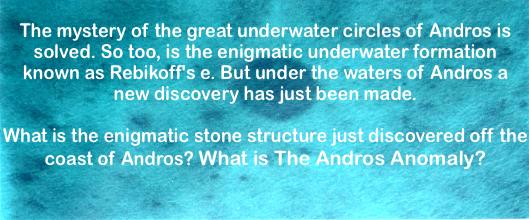 | ||
Two Enigmas of Andros Island Solved—Rebikoff's "e" Is Natural Another Genuine Mystery Emerges: The Andros Anomaly by Dr. Gregory L. Little —Copyright 2003 by G. Little— Reproduction of text is prohibited. On March 14, 2002 we returned to Andros Island with the sole intention of solving the mystery of Rebikoff's "e." The enigmatic formation, shaped like the cursive letter e, was first reported by Russian oceanographer Demetri Rebikoff in 1969. It lies off the northwestern shore of Andros, but has only been seen by a few people since that time. Several Charles Berlitz books have included a photo of the underwater formation and Berlitz, as well as numerous others, has asserted that it couldn't be natural. Combined with the many unusual circular formations found all along southwestern Andros, Rebikoff's e has long been used as evidence that underwater manmade structures are present in the area. In February my wife Lora and I went to Andros (the largest Bahama island) as part of the Association for Research & Enlightenment's Search for Atlantis Project. While I do not view the idea of Atlantis as an ancient technological culture that surpasses the present, I do see real evidence indicating that a maritime civilization probably existed in the Bahamas during the last Ice Age. This culture, I now believe, was an island empire that stretched from the Gulf of Mexico to the Mediterranean—just as Plato said. It was far more advanced than the stone age culture that emerged after some form of catastrophic event occurred sometime around 9500 B.C. Andros Investigation In the last issue of Alternate Perceptions I presented our findings on the "concentric stone circles of Andros. We feel certain we found the formation in extreme southwestern Andros. But as it turned out, it is clearly a natural formation. During that trip we were able to view Rebikoff's e from the air, but the seaplane that landed and picked us up on the last day wasn't prepared to take us to the enigmatic e, despite having all the necessary information prior to landing. Finding the e formation from the air was made easy by earlier investigators. In the late 1990s, archaeologist Bill Donato conducted two "Project Alta" investigations at Bimini, but he also included two aerial surveys in his investigations. The aerial surveys consisted of a fly around of coastal Andros. In his reports Donato included GPS readings of the formation. We had little trouble finding the formation due to Donato's work. For those interested, both of Donato's extensive reports can be viewed at the A.R.E. library at Virginia Beach. It is maintained in a reserve room and cannot be checked out by the public. However, it contains a host of interesting photos and other information. In addition, if you are interested in seeing more extensive reports on our Search for Atlantis Project, visit the ARE Ancient Mysteries website. Better yet, join the ARE and also get our monthly Ancient Mysteries newsletter. We began our most recent trip to Andros by obtaining more aerial GPS readings on the location of the e, and then headed south along the coast to obtain more video of the circles. After landing in North Andros, we quickly secured the services of a boat and guide. At 6:30 am the next morning we took the boat to Red Bay and began the search. Despite having 4 different GPS readings on the e from the air (none of which were identical), and having two different GPS handhelds on the boat, finding it proved very difficult. High winds and waves of 2-3 feet played havoc with visibility. It took 30 minutes on a 50 mph speedboat to reach the general area and the winds and waves forcefully swept us around. After 20 minutes of looking, we spotted a dark formation on the bottom. I jumped in the water with snorkeling gear and a camera. The water was about 12 feet deep. The formation turned out to be a perfect dark circle. It was formed by seaweed and sponges. Only an inch or so of sand was on the limestone seabed. Disappointed but still hopeful, we began looking again by averaging the GPS coordinates from the plane. After 20 more minutes, we found it. The e-shape was clearly visible from the surface despite the heaving water. I plunged into the 12-foot-deep water and quickly went to the bottom. The bottom was completely flat and mostly white sand and limestone. The e, about 40 feet across, was an unusual formation of seaweed. While I had hopes that the formation would turn out to be a structure, I knew that it would most likely turn out to be seaweed. Our aerial surveys had shown every conceiveable shape under the waters of the Bahamas. We had seen X, G, ?, and even swastica shapes in various places. Nevertheless, I was pleased that a 35-year-old mystery had been solved. Discovery of The Andros Anomaly This trip to Andros was planned to be short and intense. It was Saturday March 15 when we found the e formation, and we had chartered a plane back to Ft. Lauderdale the next day at 1:00 pm. The weather had been bad on the way in and severe thundershowers pounded Andros as soon as we returned to our room Saturday afternoon. Weather forecasts for the next day showed that we might still be able to leave, so we had every intention of returning home. In addition, we planned the trip knowing that the Iraq war could begin soon. Saturday evening, during a break in the torrential rains and winds, a light knock was heard on our door. (We were the only "guests" present in the entire "motel.") I answered the door and was met by an American who had heard about what we were doing. He was about 65-years old, and had been a dive operator on Andros until he sold his business several years ago. Initiially, he was convinced that we had to be looking for gold and treasure. After an hour of discussion, he became convinced that we had no interest in treasure hunting. He was extremely experienced as a diver and traveler. In our forthcoming book and video, we will cite his name and give more information, but for the moment that's all the information we wish to reveal. He told us that he had been to the Bimini Road several times in the past. He said that he didn't know what the road was, but that it was unique in his diving experience. He had never encountered anything like it anywhere else—UNTIL 1992! He then told us that he had seen something like the Bimini Road at Andros. It appeared, he said, after Hurricane Andrew blasted the island in 1992. He had only seen the formation once from the upper deck of his dive boat. The water he said, had been perfectly clear that day and he could see the stones plainly. It was, according to him, "much larger than the Bimini Road." We then began asking a series of questions, all of which he quickly answered. He hadn't swam, or snorkeled, nor dived it. The reason was that it was in water too shallow for divers. Nor had he ever told anyone else about it. It was "filed away," he said, "all dive masters like to keep their best places secrets." When I asked him why it was kept a secret if he never intended to use it as a dive site, he simply replied that dive operators just keep such things secret. Gradually he told us the general area of the formation. It could be accessed from shore by going through deep water and a reef. It was between two reefs which he thought might be 100 yards or so from shore. He said that he might come by the next morning to take us to the general area, but he wasn't sure. Lora and I went to bed that night sort of stunned. The man had seemed credible, but it just didn't seem possible. The next morning it became clear that the man wasn't going to come by. Lora and I then quickly walked to the shore area he had indicated carrying our cameras and video equipment and my skorkeling gear. The weather was getting bad. In fact, not long after we finished, a violent storm hit that knocked out the electricity. Despite my fears of swimming out so far alone, I was determined to at least look at the area. I began by swinning out 100 yards, then 200 yards, eventually getting to 400 yards or so. The water was clear and about 25 feet deep. The bottom showed scattered debris but was basically flat and sandy. A strong tide flowed right into the shore along with winds and waves coming in the same direction. With time fast passing, I decided to move to a different shore area and go straight out over the reef. After struggling out to 150 yards or so, the current became very strong. It was an effort to make any progress. But the water became shallower and shallower. And suddenly, I was on top of something amazing. It was a platform about 100-150 feet wide. The water's depth over it was a uniform 12 feet. On top of the platform are gigantic, perfectly smooth, mostly rectangular blocks. Because I wasn't really expecting to find anything, I wasn't prepared to make measurements. Thus it was difficult to guage the true size of the stones. A rough estimate is that some of the completely-exposed stones were at least 15 feet by 30 feet. A few I believe could have been as long as 50 feet and as wide as 30 feet. I was able to find a small section of exposed stone on one of the sides of the platform and it appeared that the top stones were very thick. There were three distinct and seemingly uniform sections comprising the platform's width. The three sections ran up and down the length of the platform in three close bands. Each of the sections was usually formed by a uniform row of gigantic stones. I swam an unknown distance down the platform's length, never reaching the ends. I estimate the length I swam at much less than half a mile, perhaps 200-400 yards. I was able to take 24 pictures. Most of the photos came out well and by enhancing the contrast a great deal of details emerged. I can't say that the stones were cut and fitted together, nor can I say that it looked natural. There were numerous straight seams running between the stones and a number of right angles were clearly visible. Some of the stones were irregularly cracked and many were covered with sand, but I saw no signs of settling. Here and there coral was beginning to grow, but it was obviously very young coral. The seams between most of the stones had filled with sand and seaweed was growing in them. Sand had also filled various cracks with seaweed popping through. Some sections of the stones had been cracked and broken forming what at first glance appears to be smaller fitted stones, but a better explanation appears to be that the smaller stones had been part of the larger ones. The sides of some of the stones on top of the platform are beginning to show a "pillow-like" shape possibly due to erosion. Our tentative term for this formation, whatever it is, is The Andros Anomaly. We may be seeing how something like the Bimini Road forms from a larger stone formation. We could be looking at an unusual natural reef. But it could be something else. One possibility that bears investigation is what marine geologists refer to as beachrock. Due to the relative shallowness of the water over the platform (12 feet or so), we can be certain that it was above the sea level about 6,000 years ago and earlier. It may have been a formation of beachrock called "banded" beachrock. On the other hand, it looks completely different from all of the available beachrock photos that are widely available. For example, Louisiana State University maintains a scientific digital photo database accessible via the internet. There are several hundred photos of every known type of beachrock in their files. Not one of the photos is close to the Andros Anomaly appearance. Back to Andros When we returned to Memphis on March 16 we immediately began researching reef formation, underwater geology, and other relevant information. Initially we thought that the formation had a resemblance to what is called a "flat reef," but that does not appear to be the case. Due to this unexpected discovery, we now have to return to Andros. Our time that last day was extremely limited. We were unable to measure the formation and because I had to return to shore to change film in the underwater camera, all I could do was shoot one roll. We plan to make a full investigation of the formation later this month. | ||
 | ||||
 | ||||
The Illustrated Encyclopedia of Native American Mounds & Earthworks — by Dr. Greg Little | ||